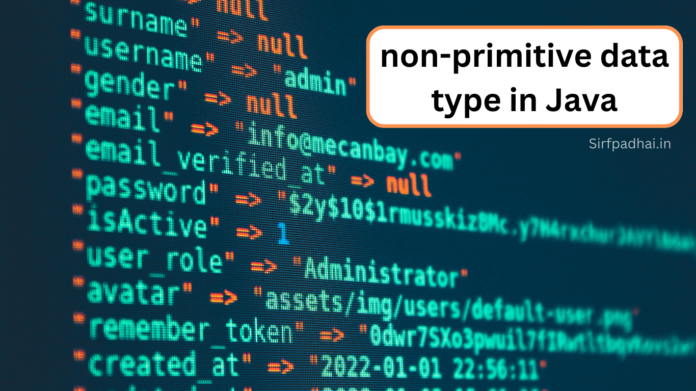non-primitive data type in Java
Java, a powerhouse in programming, categorizes data into two main types: primitive and non-primitive. While primitive types like int and char handle basic values, non-primitive data types in Java (also called reference types) unlock advanced functionality by storing complex data structures and enabling object-oriented programming (OOP). This guide dives deep into non-primitive data types, their use cases, and how they shape robust Java applications.
What Are Non-Primitive Data Types in Java?
Non-primitive data types are reference types that point to objects stored in the heap memory. Unlike primitive types, which hold raw values, non-primitive types store memory addresses, allowing dynamic memory allocation and complex operations. Key characteristics include:
- Default Value:
null(no inherent value until assigned). - Memory Allocation: Stored in the heap, with references in the stack.
- Inheritance: All non-primitive types inherit from Java’s
Objectclass.
Primitive vs. Non-Primitive: A Quick Comparison
| Feature | Primitive Types | Non-Primitive Types |
| Storage | Stack memory | Heap memory |
| Size | Fixed | Dynamic |
| Operations | Limited (e.g., +, -) | Methods & OOP features |
| Example | int, boolean | String, ArrayList |
Examples of Non-Primitive Data Types in Java
Java’s non-primitive data types include classes, interfaces, arrays, strings, and enums. Let’s explore each with practical examples.
1. Classes: The Building Blocks of OOP
Classes define blueprints for objects. For instance, a Person class can encapsulate attributes (name, age) and methods (walk, talk):
public class Person {
String name;
int age;
void speak() {
System.out.println("Hello, I'm " + name);
}
} Creating an object:
Person person1 = new Person(); person1.name = "Alice"; person1.speak(); // Output: Hello, I'm Alice
2. Interfaces: Contracts for Classes
Interfaces declare methods that classes must implement. For example:
interface Drivable {
void accelerate();
void brake();
}
class Car implements Drivable {
public void accelerate() {
System.out.println("Car speeding up!");
}
public void brake() {
System.out.println("Car stopping...");
}
} Interfaces promote polymorphism and code flexibility.
3. Arrays: Storing Collections
Arrays hold multiple values of the same type. Unlike primitives, arrays are objects:
int[] numbers = {10, 20, 30};
String[] names = new String[3];
names[0] = "John"; 4. Strings: Immutable Character Sequences
Though often mistaken for primitives, Strings are objects under the hood:
String greeting = "Hello World"; System.out.println(greeting.length()); // Output: 11
Strings are immutable; modifications create new objects. For mutable strings, use StringBuilder.
5. Enums: Defining Constants
Enums (introduced in Java 5) represent fixed sets of constants:
enum Day { MONDAY, TUESDAY, WEDNESDAY }
Day today = Day.MONDAY; Why Use Non-Primitive Data Types in Java?
Non-primitive types are indispensable for:
- Object-Oriented Programming: Enable encapsulation, inheritance, and polymorphism.
- Dynamic Memory Management: Allocate memory at runtime for scalability.
- Code Reusability: Libraries like
ArrayListorHashMapsimplify complex tasks. - Real-World Modeling: Represent entities (e.g., users, orders) with classes.
Best Practices for Using Non-Primitive Data Types
- Avoid Null References: Initialize objects to prevent
NullPointerException. - Leverage Generics: Ensure type safety in collections (e.g.,
ArrayList<String>). - Optimize Memory: Use
StringBuilderfor heavy string manipulation. - Favor Composition: Combine classes for flexible designs over deep inheritance.
- Implement Interfaces: Decouple code for easier maintenance.
Conclusion
Mastering non-primitive data types in Java is crucial for building scalable, object-oriented applications. Developers can harness Java’s full potential by understanding classes, interfaces, arrays, and strings. Follow best practices to optimize memory, reduce errors, and write clean, maintainable code.
Whether you’re designing a complex system or a simple app, non-primitive types are your toolkit for success.
FAQ:-
Is String a primitive data type?
No,
Stringis a class in Java, making it a non-primitive type.How do non-primitive types impact memory?
They use heap memory, which is dynamically allocated but requires garbage collection.
Can non-primitive types be immutable?
Yes. Examples include
Stringand custom immutable classes (declare fields asfinal).What’s the default value of non-primitive types?
null, meaning they don’t reference any object until assigned.







